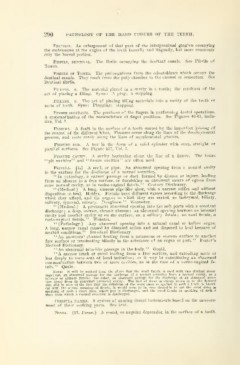Page 548 - My FlipBook
P. 548
290 PATHOLOGY OF THE HABD TISSUES OF THE TEETH.
Festoon. An enlargement of that part of the interproximal gingivae occupying
the embrasures at the angles of the teeth buccally and lingually, but more commonly
only the buccal portion.
FiBBlLS, DENTINAL. The fibrils occupying the dentinal canals. See Fibrils of
Tomes.
Fibrils of Tomes. The prolongations from the odontoblasts which occupy the
dentinal canals. They reach from the pulp chamber to the enamel or cementum. See
Dentinal fibrils.
Filling, n. The material placed in a cavity in a tooth; the resultant of the
act of placing a filling. Syns. : A plug; a stopping.
Filling, v. The act of placing filling materials into a cavity of the tooth or
roots of teeth. Syns: Plugging; stopping.
Finger positions. The positions of the fingers in performing dental operations.
A systematization of the nomenclature of finger positions. See Figures 46-61, inclu-
sive, Vol. 2.
Fissure. A fault in the surface of a tooth caused by the imperfect joining of
the enamel of the different lobes. Fissures occur along the lines of the developmental
grooves, and more rarely along the lines of supplemental grooves.
Fissure bur. A bur in the form of a solid cylinder with even, straight or
parallel surfaces. See Figure 137, Vol. 2.
Fissure cavity. A cavity beginning along the line of a fissure. The terms
"pit cavities" and "fissure cavities" are often used.
Fistula. [L] A reed, or pipe. An abnormal opening from a normal cavity
to the surface for the discharge of a normal secretion.
' ' In pathology, a narrow passage or duct, formed by disease or injury, leading
from an abscess to a free surface, or furnishing an abnormal means of egress from
some normal cavity, as in vesico-vaginal fistula." Century Dictionary.
"(Medical.) A long, sinuous pipe-like ulcer, with a narrow orifice and without
disposition to heal. Hoblyn. Fistulse have different names according to the discharge
which they afford, and the organs in which they are seated, as lachrymal, biliary,
salivary, synovial, urinary. Dunglison. ' ' Worcester.
" (Medical.) A permanent abnormal opening into the soft parts with a constant
discharge; a deep, narrow, chronic abscess; an abnormal opening between an internal
cavity and another cavity or on the surface, as, a salivary fistula ; an anal fistula, a
' Webster.
recto-vaginal fistula. '
"(Pathology.) Any abnormal opening into a natural canal or hollow organ.
A long, narrow canal caused by diseased action and not disposed to heal because of
morbid conditions." Standard Dictionary.
"An unnatural channel leading from a cutaneous or mucous surface to another
free surface or terminating blindly in the substance of an organ or part. ' ' Foster 's
Medical Dictionary.
' '
' An abnormal tube-like passage in the body. ' Gould.
"A narrow track or canal leading from a free surface, and extending more or
less deeply to some seat of local irritation; or it may be constituting an abnormal
communication between two or more cavities, as in the case of a vesico-vaginal fis-
tula. ' ' Quain.
Note: It will be noticed from the above tluit the word fistula is used with two distinct mean-
ings : one, an abnormal passage for the discharge of a normal secretion from a normal cavity, as a
salivary or urinarv fistula ; the other, an abnormal passage for the discharge of an abnormal secre-
tion (pus) from an abnormal (abscess) cavity. The first of these meanings seems to be the favored
one, and in view of the fact that the definition of the word sinus as applied to such a tract, is identi-
cal with the second meaning of fistula, it wo\ild seem to be very desirable to use the woril sinus in
•peaking of such a tract from which pus is discharged, and the word fistula in speaking of such a
tract from which a normal secretion is discharged.
Formula names. A system of naming dental instruments based on the measure-
ment of their working parts. See text.
Fossa. (PI. Fossae.) A round, or angular depression in the surface of a tooth.


